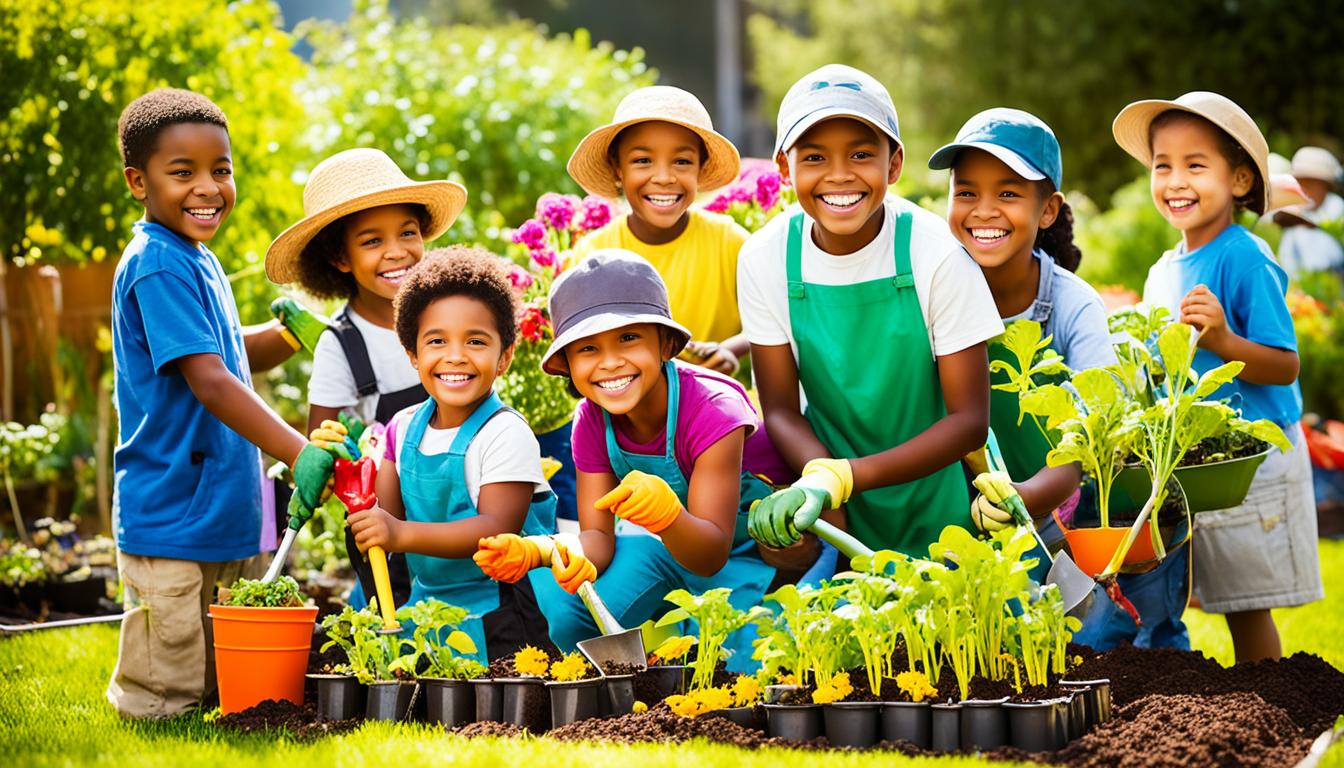Gardening with kids is not only a fantastic way to spend quality time together, but it also helps them develop a love for nature. Engaging in gardening activities can provide children with fun and educational experiences that foster curiosity and creativity. Whether you have a sprawling backyard or just a small windowsill, there are plenty of gardening projects that can be enjoyed by children of all ages.
Allowing children to get their hands dirty and experience the wonders of nature can have a lasting impact. Gardening helps kids learn about plant growth, the importance of caring for living things, and the benefits of sustainable practices. Plus, it can instill in them a sense of responsibility and appreciation for the environment.
From simple activities like planting seeds in eggshells to building sunflower forts, there are endless possibilities for fun and engaging projects that cater to their little green thumbs. Let’s explore some exciting gardening activities that will ignite your child’s passion for nature and provide them with valuable learning opportunities.
Key Takeaways:
- Engaging in gardening activities with kids promotes hands-on learning and develops fine motor skills.
- Gardening helps foster a love for nature and appreciation for the environment.
- By teaching important lessons about sustainability, kids can learn the value of reducing waste and caring for living things.
- Creating a garden together allows for quality family time and creates lasting memories.
- Children of all ages can enjoy gardening, regardless of the available space.
Eggshell Countertop Garden
Looking for an easy and engaging gardening project for your little ones? Why not try creating an eggshell countertop garden! This activity is not only fun but also educational, allowing kids to learn more about gardening and nurture their own little plants.
To get started, gather some basic supplies that can be easily found in your kitchen:
- Egg cartons or seed starting kits
- Clean eggshells
- Soil
- Spoons
- Seeds
- Markers
Once you have all the supplies ready, let the creativity begin! Encourage your kids to decorate the eggshells using markers, creating unique designs or even labeling them with the names of the herbs they will plant.
It’s fascinating to see how little green thumbs can transform plain eggshells into colorful mini gardens.
Next, fill each eggshell with soil, leaving some space at the top for planting the seeds. Help your kids choose their favorite herbs or small plants to sow into the eggshells. Some popular options include basil, parsley, or chives.
Place the eggshell garden in a sunny spot, like a windowsill, where it can receive adequate sunlight. Remind your kids to water their little gardens regularly, ensuring that the soil remains moist but not waterlogged.
As the days go by, children will be excited to see tiny sprouts emerging from the eggshells. It’s a great opportunity for them to learn about the process of seed germination and plant growth.
Encourage your kids to take care of their eggshell gardens, monitoring the progress of their plants, and providing proper care. They will experience a sense of accomplishment as they witness their herbs grow bigger and stronger each day.
This engaging gardening project not only teaches children the importance of nurturing plants but also allows them to have a connection with nature right in their own homes.
So why not embark on this fun-filled gardening adventure with your kids? It’s an activity that stimulates their creativity, fosters their love for nature, and introduces them to the wonders of gardening.
Eggshell Countertop Garden Supplies
| Supplies | Description |
|---|---|
| Egg cartons or seed starting kits | Containers to hold the eggshells |
| Clean eggshells | Empty eggshells for planting the herbs |
| Soil | High-quality soil for optimal plant growth |
| Spoons | To scoop and transfer soil |
| Seeds | Herb seeds for sowing into the eggshells |
| Markers | To decorate the eggshells |
Vegetable Scrap Regrowing
In addition to the fun and educational activities we’ve explored so far, another engaging gardening project for kids is teaching them how to regrow vegetables from scraps. Not only does this activity promote sustainability, but it also provides children with a tangible way to witness the growth and transformation of plants.
Many common vegetables can be easily regrown from scraps, allowing kids to learn about the fascinating process of plant regeneration. Some examples of vegetables that can be regrown include avocados, carrots, celery, mint, onions, and lettuce.
When cooking with these vegetables, encourage your kids to save the scraps instead of throwing them away. You can then show them how to regrow the vegetables using simple steps right at home.
How to Regrow Vegetables from Scraps:
- Avocados: After enjoying a delicious avocado, wash the seed and insert toothpicks around its midsection. Place the seed in a glass jar with the bottom immersed in water. Keep the jar in a sunny spot and change the water every few days. Soon, your child will observe the seed germinating and sprouting roots.
- Carrots: Cut off the top inch of a carrot, leaving a small portion of the green stems intact. Place the carrot top in a shallow dish with water, ensuring that the bottom of the carrot touches the water. Set the dish on a sunny windowsill and refill the water as needed. Within a week, your child will witness tiny green shoots emerging from the top of the carrot.
- Celery: Cut off the bottom inch or two of a celery stalk and place it in a shallow dish filled with water. Make sure the cut side is facing up. Keep the dish in a sunny location and add water as needed. After a few days, your child will observe new leaves sprouting from the center of the celery base.
Your little green thumbs will delight in the process of watching their vegetable scraps transform into new plants. This hands-on experience not only fosters an appreciation for nature but also encourages sustainable practices by reducing waste.
By incorporating vegetable scrap regrowing into your gardening activities, you can teach your children important lessons about resourcefulness, conservation, and the inherent power of nature.
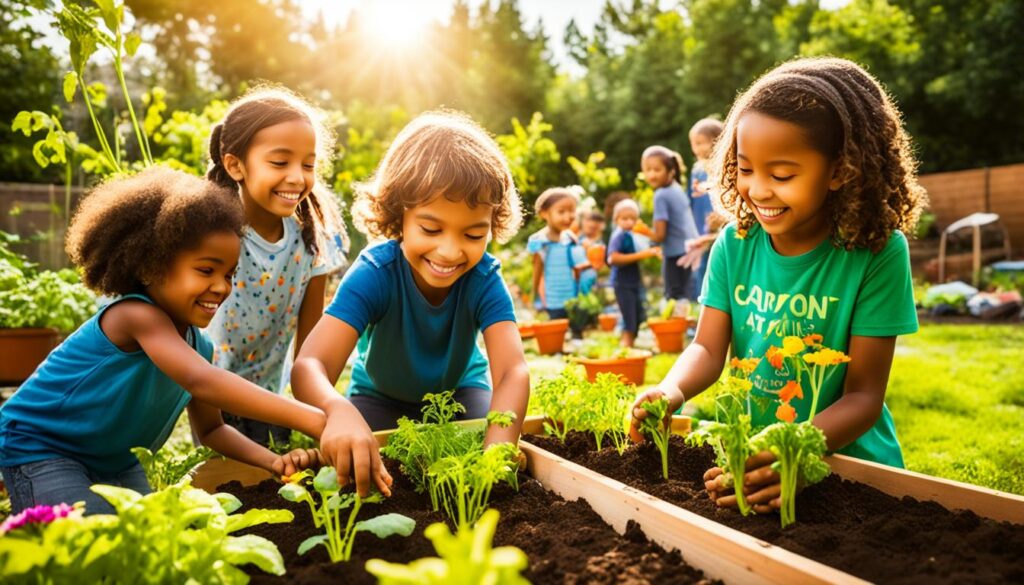
Toilet Paper Tube Seed Starter
Looking for a creative and eco-friendly way to start seeds with your kids? Look no further than your bathroom! Utilizing empty toilet paper tubes as seed starters is a fun and engaging gardening project that also helps reduce waste.
Here’s how to make your own toilet paper tube seed starters:
Materials:
- Empty toilet paper tubes
- Scissors
- Soil
- Seeds
- Spray bottle filled with water
Instructions:
- Start by making cuts at the bottom of the toilet paper tubes, creating four equal sections.
- Fold the cut sections inward to create a sturdy base for the tube.
- Fill the tubes with soil, leaving a little space at the top for the seeds.
- Plant your seeds according to the instructions on the seed packets. Make sure to choose seeds that are appropriate for the current season and your gardening zone.
- Label each tube with the name or type of plant using markers or stickers. This helps kids keep track of what they’ve planted.
- Using a spray bottle, gently mist the soil with water. Avoid overwatering, as it may cause the seeds to rot.
- Place the seed starters in a warm and bright area, such as a sunny window sill or a greenhouse. Make sure they receive proper sunlight and maintain the moisture level in the soil.
- Once the seedlings have grown and the weather is appropriate, you can transplant the entire tube directly into pots or the garden. The cardboard tubes will gradually decompose, providing extra nutrients to the plants.
By repurposing toilet paper tubes, you not only engage your kids in a gardening activity but also teach them about sustainability and the importance of recycling. It’s a win-win for both the environment and your little green thumbs!
Note: Always supervise young children during gardening activities and ensure they handle scissors and soil with care.
Grow Potatoes in a Ball Jar
Looking for a unique and engaging gardening project for your kids? Why not try growing potatoes in a ball jar! This fun activity can be done using kitchen scraps and allows children to witness the growth process of plants up close. It’s not only educational but also encourages kids to develop a sense of responsibility by taking care of their own potato plant.
To get started, all you need are a few basic supplies:
- A ball jar or any clear glass container
- A potato
- Toothpicks
- Water
Here’s how to grow potatoes in a ball jar:
- Take a potato and carefully pierce it with toothpicks. The toothpicks will act as support, keeping the potato suspended in the jar.
- Fill the jar with enough water to cover the bottom part of the potato.
- Place the jar in a sunny spot, like a windowsill, where it will receive adequate sunlight.
- Make sure to keep the water level consistent by adding more water when needed.
- Over time, kids will start to see the potato sprouting green shoots. This is the exciting part!
- Encourage your little gardener to observe the growth progress and take responsibility for watering the plant regularly.
This project is not only a hands-on learning experience but also a great way to introduce children to the fascinating world of gardening. They will gain a deeper understanding of how plants grow and the importance of nurturing them.
“I loved watching my potato sprout and grow in the ball jar. It made me feel like a real gardener!” – Lily, age 8
So, gather your supplies and let your kids embark on this exciting potato-growing adventure. It’s a simple yet captivating project that will ignite their curiosity and foster a love for gardening.
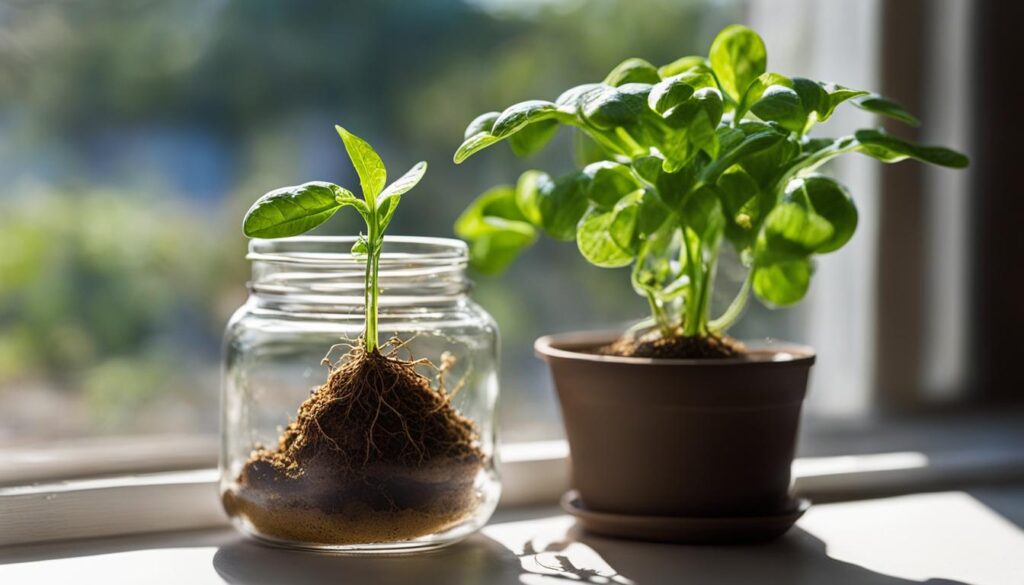
Note: Ensure that the jar is always clean and the water is changed regularly to prevent any bacterial growth.
Sprout Some Seeds
Growing sprouts from seeds is an exciting and educational gardening activity that children can enjoy. It’s a fast and rewarding project that allows kids to witness the magic of tiny seeds transforming into vibrant sprouts in just a few days. Not only does it offer a hands-on learning experience, but it also promotes healthy eating habits by incorporating nutritious sprouts into kids’ diets.
To start sprouting seeds, you can use simple materials such as mason jars or a sprouter. Here’s a step-by-step guide:
- Select your desired seeds. Popular choices include alfalfa, broccoli, radish, and mung bean.
- Place a tablespoon of seeds in a clean mason jar or a sprouter.
- Rinse the seeds with water and drain out the excess.
- Fill the jar halfway with water and let the seeds soak for a few hours or overnight.
- After soaking, drain the water from the jar and rinse the seeds again.
- Secure a piece of breathable cloth or mesh on the top of the jar using a rubber band or the sprouter’s lid.
- Place the jar in a well-lit area, away from direct sunlight.
- Twice a day, rinse the seeds with water, gently swishing them around, and drain out the water.
- Continue rinsing and draining until the sprouts have reached the desired length. This usually takes about 3-7 days, depending on the type of seeds.
- Once the sprouts are ready, give them a final rinse and gently pat them dry.
Now, your little gardeners can enjoy their freshly sprouted seeds in various ways. Sprouts can be added to salads, sandwiches, wraps, or even blended into smoothies for an extra dose of nutrition. Encourage your kids to get creative with recipes and explore different flavors!
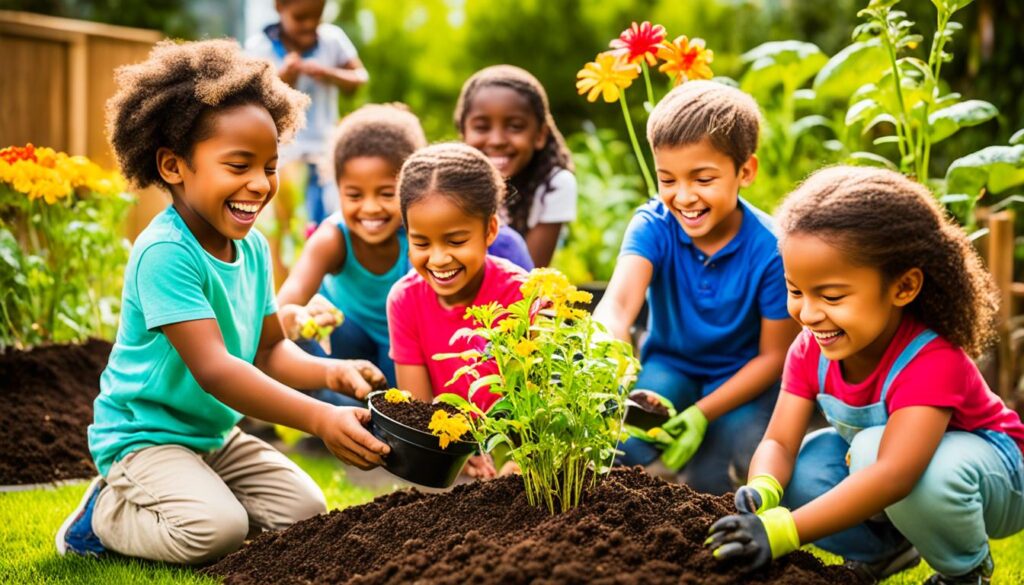
Engaging kids in sprouting seeds not only teaches them about plant life cycles but also encourages them to appreciate the wonders of nature. It’s a wonderful opportunity for children to observe the growth process up close and develop a deeper connection with the natural world. So, grab some seeds and let your little ones embark on a sprouting adventure!
Plant a Tree
Planting a tree is an excellent gardening activity for children that not only teaches them about plants and nature but also allows them to make a positive impact on the environment. By ordering bare root trees and planting them in early April, kids can witness the growth of these trees and contribute to a healthier planet.
One of the remarkable benefits of planting trees is their ability to provide oxygen, which is essential for our atmosphere. Trees also offer shade, creating a cool and comfortable space to relax and play during hot summer days. Additionally, trees provide homes for various wildlife, attracting birds, squirrels, and other fascinating creatures to the garden.
There are many tree options suitable for planting in a children’s garden. The Nanking Bush Cherry is a great choice as it produces beautiful and edible cherries, offering both aesthetic and flavorful rewards. The Prolific Pawpaw is another fantastic option, known for its delicious and tropical-flavored fruits. Finally, the Meader American Persimmon tree is a delightful addition, as its sweet and vibrant persimmons make for a tasty treat.
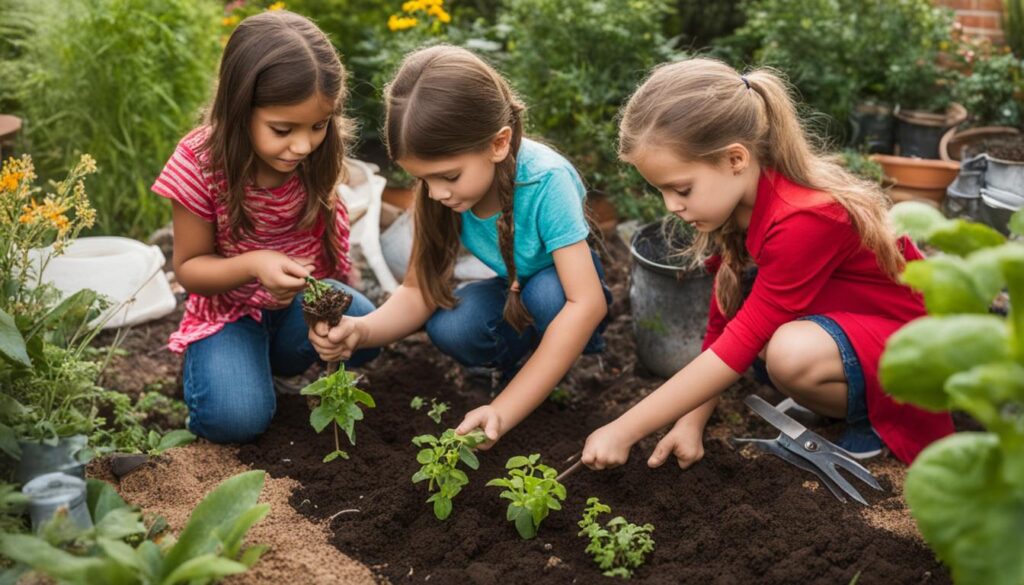
Planting a tree is an activity that not only teaches kids about the natural world but also instills a sense of responsibility and care for the environment. It allows them to witness the growth process first-hand and understand the importance of nurturing and preserving these valuable resources. Plus, seeing the tree they planted thrive and flourish will bring them a sense of pride and accomplishment.
Make a Butterfly Puddle
Creating a butterfly puddle is a quick and impactful activity that introduces children to the wonders of nature. By engaging in this gardening activity, kids not only learn about plants and nature but also contribute to the well-being of butterflies in their own backyard.
To start, plant flowers that attract butterflies, such as butterfly bush, lavender, or coneflowers. These vibrant blooms will serve as a magnet for these delicate creatures, inviting them to visit your garden.
Next, provide a shallow container filled with sand, water, and a small amount of soil or salt. The container should be placed in a sunny spot in the garden, preferably near the flowering plants. Butterflies are attracted to the minerals found in the soil or salt, which they need to maintain their health and vitality.
By creating a butterfly puddle, children not only get to witness the beauty of butterflies up close but also play a role in their survival. They learn about the importance of creating a supportive habitat and how even the smallest actions can make a significant impact on the ecosystem.
Observing butterflies as they flutter around your garden brings joy and a sense of wonder to children. It opens up opportunities for further exploration and learning about different species of butterflies, their life cycles, and their role in pollination.
Benefits of the Butterfly Puddle:
- Teaches children about the importance of supporting a thriving ecosystem
- Encourages curiosity and observation skills
- Promotes an appreciation for the beauty of nature
- Provides an opportunity to learn about different butterfly species and their habitats
- Fosters a sense of responsibility towards the environment
“Creating a butterfly puddle is not only a fun gardening activity but also a meaningful way to introduce children to the wonders of nature and the importance of protecting our ecosystem.” – Jane Smith, Gardening Enthusiast
Flowers that Attract Butterflies
| Flower | Butterfly Attracted |
|---|---|
| Butterfly Bush | Various butterfly species |
| Lavender | Small Blue butterflies |
| Coneflowers | Eastern Tiger Swallowtail |
Build a Sunflower Fort
Looking for a fun and engaging gardening activity for older kids? Look no further than building a sunflower fort! This classic outdoor project allows children to get creative while learning about plants and nature.
To start, you’ll need to plant sunflowers in your garden. Sunflowers are not only beautiful, but they also provide a great structure for a fort. Choose a sunny spot in your yard and sow the seeds according to the instructions on the packet. Make sure to leave enough space for the fort to take shape!
As your sunflowers start to grow, gather some basic supplies to transform them into a fort. Here’s a list of materials you’ll need:
- Bamboo stakes or long sticks
Once your sunflowers are tall enough, carefully insert the bamboo stakes or long sticks into the ground around the perimeter of the sunflower patch. Use string or twine to connect the stakes and create a frame for your fort.
Now, it’s time to add the walls! Attach blankets or sheets to the frame using tape or safety pins. Encourage your kids to decorate the fort with their favorite artwork or use nature-themed decorations to enhance the garden atmosphere.
Benefits of Building a Sunflower Fort:
Building a sunflower fort is not only a fun gardening activity, but it also offers various educational benefits:
- Hands-on learning: Kids learn about plant growth and the importance of sunlight and water in nurturing plants.
- Creativity: Designing and decorating the fort allows children to express their artistic flair and imagination.
- Nature and sensory experience: Being surrounded by sunflowers creates a sensory-rich environment with vibrant colors and the gentle rustling of leaves in the breeze.
- Socialization and teamwork: Building a fort together promotes teamwork and cooperation among siblings or friends.
- Outdoor enjoyment: Spending time outdoors, breathing in the fresh air, and soaking up vitamin D from the sun is essential for children’s overall well-being.
So, gather your materials, plant some sunflowers, and watch as your kids enjoy building their very own sunflower fort. It’s a magical way to combine gardening activities for children with teaching them about plants and the wonders of nature.
Garden Stone Painting
Looking for a creative and artistic activity to engage your children in gardening? Look no further than garden stone painting! This fun and interactive project allows kids to express their creativity while also learning about plants and nature.
To get started, encourage your little ones to explore the yard or go on a neighborhood walk to find stones of different shapes and sizes. These stones will serve as their canvases for painting.
Once they have gathered their stones, provide them with non-toxic acrylic paints and paintbrushes. Let their imagination run wild as they design and decorate the stones with bright colors, patterns, and even pictures of their favorite plants and herbs.
Not only does garden stone painting unleash their artistic abilities, but it also serves a practical purpose in the garden. These painted stones can be used as unique garden markers to identify different plants and herbs. It adds a personal touch to your garden while teaching kids about various plants and their characteristics.
Display their painted stones by placing them strategically throughout the garden, near the corresponding plants. This not only creates an aesthetically pleasing environment but also helps children remember the names and features of the plants they have painted.
Tip: To make the painted stones more durable and weather-resistant, you can apply a clear coat of varnish or sealer once the paint has dried.
Garden stone painting is a fantastic way to combine art and nature, fostering your children’s creativity and love for gardening. Moreover, it offers an opportunity for meaningful conversations about plants, their importance, and the role they play in our ecosystem.
Summary
- Garden stone painting is a creative and artistic way to engage children in gardening activities.
- Children can find stones in the yard or on a neighborhood walk to use as their canvases.
- Painting the stones with non-toxic acrylic paints allows kids to express their creativity.
- The painted stones can be used as garden markers to identify different plants and herbs.
- Display the painted stones near the corresponding plants to add a personal touch to the garden and reinforce learning.
Conclusion
Engaging in gardening activities with kids provides a multitude of benefits that contribute to their overall development. Through hands-on learning, children not only acquire new knowledge about plants and nature, but also develop essential fine motor skills. Gardening activities foster a love for nature and create a sense of connection with the environment, instilling in kids a lifelong appreciation for the world around them.
Furthermore, by involving children in fun and educational outdoor activities, such as regrowing vegetables from scraps or decorating garden stones, parents can nurture their little green thumbs. This interactive approach encourages kids to embrace the outdoors and spend quality time with their families, away from screens and technology.
In addition to the joy and satisfaction of watching plants grow, gardening also imparts valuable lessons about sustainability and the importance of caring for our planet. By tending to their own garden, children learn the significance of responsible resource use and gain a deeper understanding of the environment. These experiences lay the foundation for a more sustainable future, where young green thumbs become stewards of nature.
FAQ
Why is gardening with kids beneficial?
Gardening with kids offers numerous benefits, including promoting hands-on learning, development of fine motor skills, fostering a love for nature, and teaching important lessons about sustainability and the environment.
What are some fun gardening activities for children?
There are plenty of engaging gardening projects for kids, such as creating an eggshell countertop garden, teaching them how to regrow vegetables from scraps, utilizing toilet paper tubes as seed starters, growing potatoes in a ball jar, sprouting seeds, planting a tree, making a butterfly puddle, building a sunflower fort, and painting garden stones.
How can I create an interactive garden for kids?
To create an interactive garden for kids, you can incorporate activities like planting herbs, regrowing vegetables, using seed starters, growing sprouts, planting trees, attracting butterflies, building a sunflower fort, and painting garden stones. These activities will engage their little green thumbs and provide them with a fun and educational gardening experience.
What can I use to create an eggshell countertop garden?
To create an eggshell countertop garden, you will need supplies such as egg cartons or seed starting kits, clean eggshells, soil, spoons, seeds, and markers. Kids can decorate the eggshells and plant herbs to watch them grow.
Can vegetables be regrown from scraps?
Yes, many vegetables like avocados, carrots, celery, mint, onions, and lettuce can be easily regrown from scraps. Kids can learn about sustainability and enjoy watching their kitchen scraps turn into new plants.
How can I repurpose empty toilet paper tubes for gardening?
You can repurpose empty toilet paper tubes by making cuts at the bottom and folding the pieces to create a base. Kids can then fill the tubes with soil, add seeds, and spritz with water. Once the seedlings have grown, they can be transplanted into pots or the garden.
How can I grow potatoes in a ball jar?
To grow potatoes in a ball jar, pierce a potato with toothpicks and place it in a jar with water. Kids can observe as the potato sprouts greenery, teaching them about the growth process of plants and encouraging them to take care of their potato plant.
What is the process of growing sprouts from seeds?
Growing sprouts from seeds is a fast and rewarding gardening activity. Kids can sprout seeds in mason jars or using a sprouter, witnessing the tiny seeds opening and growing in just a few days. Sprouts can be added to smoothies or used in recipes, making it a fun way to incorporate healthy foods into kids’ diets.
How can planting a tree teach kids about plants and nature?
Planting a tree provides an opportunity for kids to learn about the environment and contribute to a healthier planet. By ordering bare root trees and planting them, children can witness the growth of trees that provide oxygen, shade, and homes for wildlife, encouraging them to appreciate the role of plants in nature.
What is a butterfly puddle and how can kids make one?
A butterfly puddle is a shallow container filled with sand, water, and a small amount of soil or salt, providing butterflies with a place to drink. Kids can plant flowers that attract butterflies and create a butterfly puddle in their garden, adding beauty and teaching them about supporting a thriving ecosystem.
How can kids build a sunflower fort?
Kids can build a sunflower fort by planting sunflowers and utilizing basic supplies like stakes or trellises. As the sunflowers grow, they can be positioned to create a fort-like structure, providing a fun and engaging gardening experience for older children.
What can kids do with painted garden stones?
Kids can paint garden stones with their own designs and use them as garden markers, adding a personalized touch to the garden. This activity also teaches kids about different plants and herbs, enhancing their knowledge of the garden and promoting creativity.
What are the benefits of gardening with kids?
Gardening with kids has many benefits, including spending quality time together, helping them develop a love for nature, promoting hands-on learning, developing fine motor skills, teaching important lessons about sustainability, and encouraging kids to enjoy the outdoors.

